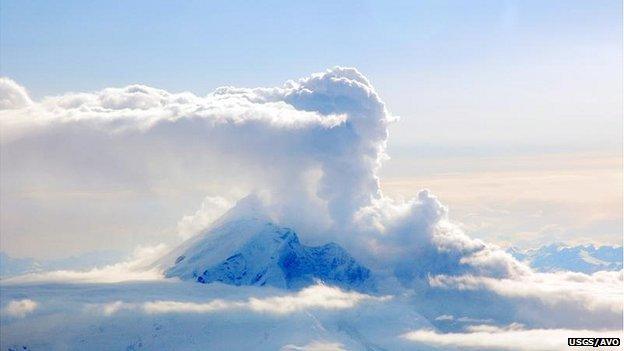Volcanic 'scream' precedes explosive eruptions
- Published

The researchers studied the eruption of Redoubt in 2009
A change in the frequency of earthquakes may foretell explosive volcanic eruptions, according to a new study.
The seismic activity changes from steady drum beats to increasingly rapid successions of tremors.
These blend into continuous noise which silences just before explosion.
The study of tremors in the lead up to the 2009 eruption of Redoubt, a volcano in Alaska, appears in Journal of Volcanology and Geothermal Research.
Those quakes continuously rose in pitch like a volcanic glissando - a musical glide from one pitch to another.
Subterranean magma plumbing systems sit beneath volcanoes and feed pressurised molten rock toward the surface before eruptions.
As the magma flows through deep conduits and cracks, it generates small seismic tremors and earthquakes.
Scientists have noted earthquakes preceding volcanic eruptions before, for example drumbeat earthquakes were the first sign of renewed magmatic activity in Mount St Helens in April 2005.
But the new analysis of Alaska's Redoubt volcano shows that the tremor glided to higher frequencies and then stopped abruptly less than a minute before eruption.
"The frequency of this tremor is unusually high for a volcano," explained Alicia Hotovec-Ellis, a doctoral student involved in the study, from the University of Washington.
"Because there's less time between each earthquake, there's not enough time to build up enough pressure for a bigger one. After the frequency glides up to a ridiculously high frequency, it pauses and then it explodes."
The earthquake noise sounds like a scream before eruption when the seismometer data are speeded up sixty times to make them audible, external. The authors suggest a simple model of brittle fracture may explain their results, although the precise details of what is going on underneath volcanoes before they erupt remain unclear.
Dr Marie Edmonds, from the University of Cambridge, who was not involved in the study, commented: "This work is probably the most intensive treatment of this phenomenon. If you can get an idea of what is causing these types of patterns then you have a route to prediction of volcanic eruptions.
"The question that arises is whether you can ever get these sorts of patterns without an eruption following?
"We had repetitive sequences of volcanic explosions in the Caribbean island of Montserrat in 1997 and 2003 which were preceded by similar tremors, with hybrid earthquakes that were periodic and then recurrence intervals decreased with time before the explosion. People are converging on a view on how magmas behave."